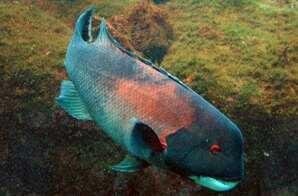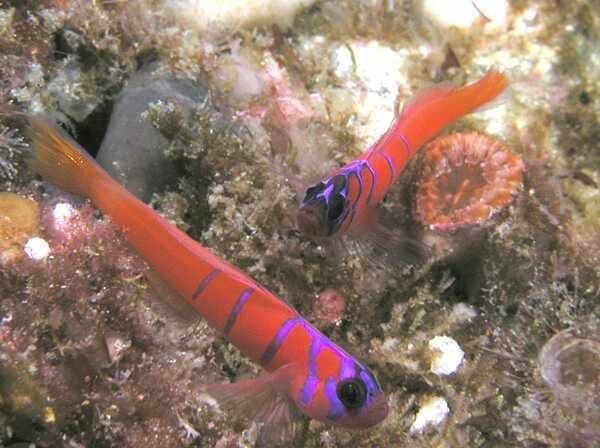Sequential hermaphroditism: how fish change sex from male to female or female to male.
Some men will want to become a woman and women who will want to become a man. We've seen this over and over again where people get surgery to change their gender. But some organisms don't need surgery to change their gender; they just change.
Maybe not as fast as waving a magic wand and suddenly change from being a male to female or the other way round. This is done to ensure that their genetic diversity continues and also for reproductive advantage.
As organisms evolve, they also develop several reproductive adaptation behaviors. Such behaviors include: producing more offspring when only a few can survive to adult; developing parental care; Producing several eggs; developing sensitive sight, taste, smell, etc, during courtship; hermaphroditism, etc...
What is Sequential Hermaphroditism?
Sequential hermaphroditism is a type of hermaphroditism that occurs in many fish, gastropods, and plants. Sequential hermaphroditism occurs when the individual changes sex at some point in its life.
Sequential hermaphrodite is different from a hermaphrodite which is an organism that has complete or partial reproductive organs and produces gametes normally associated with both male and female sexes.
In other words, sequential hermaphroditism means that at a point in the organism's life it is a female or male. And at another point, it becomes female or male as the case may be but never acting like a male and female at the same time as in the case of the hermaphrodite.
Sequential hermaphrodites can be described in three broad categories: Protandry, Protogyny, and Bidirectional Sex Changers.
protandry
Wiktionary defines protandry as the condition in which an organism begins life as a male and then changes into a female. Dominance hierarchy arises when members of a social group interact, often aggressively, to create a ranking system. In social living groups, members are likely to compete for access to limited resources and mating opportunities. Rather than fighting each time they meet, relative relationships are formed between members of the same sex. Based on repetitive interactions a social order is created that is subject to change each time a dominant animal is challenged by a subordinate one. source Dominance hierarchy simply means that there is a social structure within a group of animals in which some certain individuals are dominant over others. Such individuals usually have access to more resources like food and shelter and also mates too. Because of the dominance hierarchy that exists between the clownfish, only the two largest fish are involved in reproduction. The largest fish is the female and the second one is the male. If the largest female dies, the social hierarchy shifts with the breeding male exhibiting protandrous sex reversal to become the breeding female. The largest juvenile then becomes the new breeding male after a period of rapid growth. In a study conducted by Laura Casas et al (Sex Change in Clownfish: Molecular Insights from Transcriptome Analysis) it was reported that very little is known about the molecular pathways underlying their sex change. The analysis highlighted the rapid and complex genomic response of the brain associated with sex change, which is subsequently transmitted to the gonads, identifying a large number of candidate genes, some well-known and some novel, involved in the process. Aromatase is said to play a central role, both in the brain and the gonad. The condition in which an organism begins life as a female and then changes into a male. source Protogyny is the most common form of hermaphroditism in fish in nature. About 75% of the 500 known sequentially hermaphroditic fish species are protogynous. source To have a good understanding of protogyny, wrasse of the family Labridae is the best candidate. Many species of wrasses are capable of changing sex. They are found living in a haremic mating system consisting of juveniles (mix of males and females) and a territory-holding male. In some species of wrasses, some are born either as male or female. The female can then change when the right conditions are available to a male fish. The juvenile males are referred to as the initial phase male and the territorial male is referred to as a terminal phase male. Initial phase males do not look like males and spawn in groups with other females. The California sheep head (Semicossyphus pulcher) is a species of wrasse living in the rocky reef and kelp bed habitats. They are all born female and change into their male form at various stages in their lifecycle, determined by environmental conditions and pressures. Male and female California sheepsheads can be differentiated by their sizes. The male is larger. They also have a different pattern of body coloration. The head sections and the tail of the male are black with a reddish-orange midriff, red eyes, and fleshy forehead bumps. Female sheepshead is dull pink with white undersides. The transitional phase takes between two weeks and several months, and steroid hormone concentrations are thought to be related to sex change due to the total degradation of the ovaries and the appearance of testes. They are organisms that have female and male reproductive organs but act as either female or male during different stages in life. This type of sexual behavior is found in most gobies for the Gobiidae family. In most cases, the larger individuals change to males in a female to female pair. And smaller individuals change to females in a male to male pair. Bidirectional sex change is an effective tool for reproduction for this fish. When the larger fish (usually the male) dies, instead of the other fish to travel a long-distance between host corals which increases the risk of predation, the smaller fish easily change its sex. References:

When describing protandry, a good example that can be used is the clown fish. The clownfish also know as anemonefish, is from the family Pomacentridae and subfamily Amphiprioninae. They live in symbiotic mutualisms with sea anemones. All clownfish are born male and their colonies usually consist of the reproductive male and female and a few juveniles, which help tend the colony. A strict dominance hierarchy exists among the clownfish.
Other organisms that exhibit protandry are: Barramundi, gilt-head bream, damselfish, moray eel etc.Protogyny

California sheephead
Other examples includes: parrotfish, bluehead wrasse, Grouper, angelfish, etc.Bidirectional Sex Changers

The gonadal structures in these species simultaneously consisted of both ovarian and testicular portions separated by a thin wall of connective tissue and an accessory gonadal structure. The males have mature testis and immature ovaries; on the other hand, the females have a mature ovary and immature testis. Individuals are always capable of functioning as females or males, respectively.
Examples of fish that are bidirectional sex changers are: Broad-barred goby, blue-banded goby, Paragobiodon, Trimma yanagitai
Summary table for sequential hermaphroditism
CATEGORY MODE OF SEX CHANGE EXAMPLES Protandry from male to female clown fish, Barramundi, gilt-head bream Protogyny from female to male wrasse, parrotfish, bluehead wrasse, Grouper Bidirectional sex changers from male to female or from female to male Broad-barred goby, blue-banded goby, Paragobiodon, Trimma yanagitai
https://en.m.wikipedia.org/wiki/California_sheephead
https://en.m.wikipedia.org/wiki/Clownfish
https://en.m.wikipedia.org/wiki/Dominance_hierarchy
https://en.m.wikipedia.org/wiki/Sequential_hermaphroditism
https://en.m.wiktionary.org/wiki/protandry
https://www.ncbi.nlm.nih.gov/pmc/articles/PMC4933090/
https://www.ncbi.nlm.nih.gov/pmc/articles/PMC5066260/
https://www.ncbi.nlm.nih.gov/pmc/articles/PMC5332495/
L. Sola et al. (2007). Gilthead seabream - Sparus aurata PDF
Hello! I find your post valuable for the wafrica community! Thanks for the great post! @wafrica is now following you! ALWAYs follow @wafrica and use the wafrica tag!
Congratulations! this post got an upvote by @steemrepo and was manually picked by the curator @gamsam to be added on STEEM REPOSITORY, simply comment "YES" and we upload it on STEEM REPO Website.
Want to know more about the Steem Repo project? Contact us on Discord
Yes